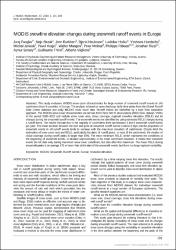| dc.contributor.author | Parajka, Juraj | |
| dc.contributor.author | Bezak, Nejc | |
| dc.contributor.author | Burkhart, John | |
| dc.contributor.author | Hauksson, Bjarki | |
| dc.contributor.author | Holko, Ladislav | |
| dc.contributor.author | Hundecha, Yeshewa | |
| dc.contributor.author | Viglione, Alberto | |
| dc.date.accessioned | 2019-10-21T21:11:30Z | |
| dc.date.available | 2019-10-21T21:11:30Z | |
| dc.date.issued | 2019 | |
| dc.identifier.issn | 0042-790X | |
| dc.identifier.issn | 1338-4333 | |
| dc.identifier.uri | https://dx.doi.org/10.2478/johh-2018-0011 | |
| dc.identifier.uri | https://hdl.handle.net/11421/21003 | |
| dc.description | WOS: 000449717800011 | en_US |
| dc.description.abstract | This study evaluates MODIS snow cover characteristics for large number of snowmelt runoff events in 145 catchments from 9 countries in Europe. The analysis is based on open discharge daily time series from the Global Runoff Data Center database and daily MODIS snow cover data. Runoff events are identified by a base flow separation approach. The MODIS snow cover characteristics are derived from Terra 500 m observations (MOD10A1 dataset, V005) in the period 2000-2015 and include snow cover area, cloud coverage, regional snowline elevation (RSLE) and its changes during the snowmelt runoff events. The snowmelt events are identified by using estimated RSLE changes during a runoff event. The results indicate that in the majority of catchments there are between 3 and 6 snowmelt runoff events per year. The mean duration between the start and peak of snowmelt runoff events is about 3 days and the proportion of snowmelt events in all runoff events tends to increase with the maximum elevation of catchments. Clouds limit the estimation of snow cover area and RSLE, particularly for dates of runoff peaks. In most of the catchments, the median of cloud coverage during runoff peaks is larger than 80%. The mean minimum RSLE, which represents the conditions at the beginning of snowmelt events, is situated approximately at the mean catchment elevation. It means that snowmelt events do not start only during maximum snow cover conditions, but also after this maximum. The mean RSLE during snowmelt peaks is on average 170 m lower than at the start of the snowmelt events, but there is a large regional variability. | en_US |
| dc.description.sponsorship | European Commission FP7 [603587]; European Research Council under the ERC [291152]; Slovenian Research Agency [P2-0180] | en_US |
| dc.description.sponsorship | This work was supported by the European Commission FP7 funded research projects "Sharing Water-related Information to Tackle Changes in the Hydrosphere - for Operational Needs" (grant agreement number 603587), the European Research Council under the ERC Advanced Grant "Flood Change", project no. 291152) and the Slovenian Research Agency (grant P2-0180). The financial support is gratefully acknowledged. We would like also to thank the Global Runoff Data Centre, Koblenz, Germany and Czech Hydrometeorological Institute for providing daily runoff data for this work. | en_US |
| dc.language.iso | eng | en_US |
| dc.publisher | Veda, Slovak Acad Sciences | en_US |
| dc.relation.isversionof | 10.2478/johh-2018-0011 | en_US |
| dc.rights | info:eu-repo/semantics/openAccess | en_US |
| dc.subject | Modis | en_US |
| dc.subject | Snowmelt | en_US |
| dc.subject | Runoff Events | en_US |
| dc.subject | Europe | en_US |
| dc.subject | Snowline Elevation | en_US |
| dc.title | MODIS snowline elevation changes during snowmelt runoff events in Europe | en_US |
| dc.type | article | en_US |
| dc.relation.journal | Journal of Hydrology and Hydromechanics | en_US |
| dc.contributor.department | Anadolu Üniversitesi, Mühendislik Fakültesi, İnşaat Mühendisliği Bölümü | en_US |
| dc.identifier.volume | 67 | en_US |
| dc.identifier.issue | 1 | en_US |
| dc.identifier.startpage | 101 | en_US |
| dc.identifier.endpage | 109 | en_US |
| dc.relation.publicationcategory | Makale - Uluslararası Hakemli Dergi - Kurum Öğretim Elemanı | en_US |


















